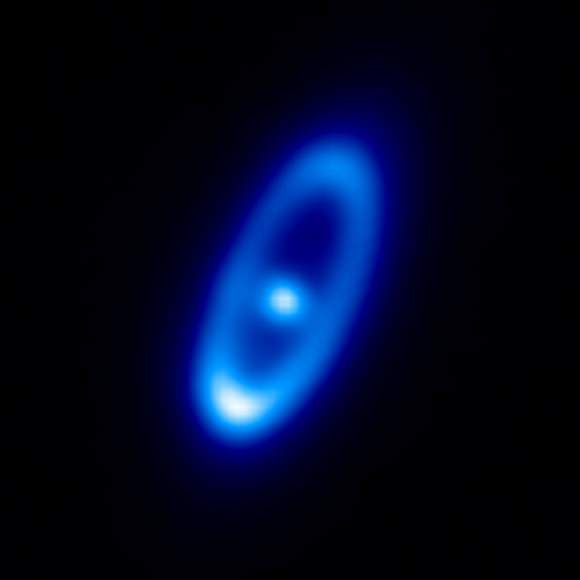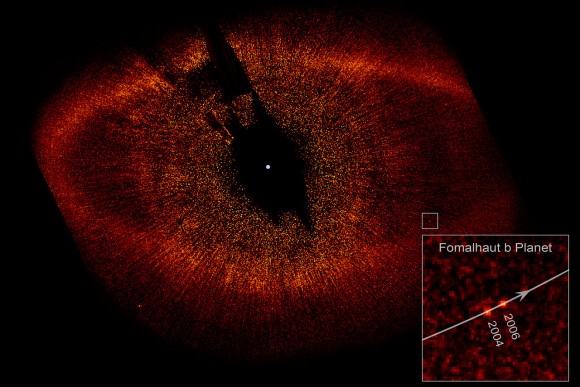There may be some frantic activity going on in the narrow, dusty disk surrounding a nearby star named Fomalhaut. Scientists have been trying to understand the makeup of the disk, and new observations by the Herschel Space Observatory reveals the disk may come from cometary collisions. But in order to create the amount of dust and debris seen around Fomalhaut, there would have to be collisions destroying thousands of icy comets every day.
“I was really surprised,” said Bram Acke, who led a team on the Herschel observations. “To me this was an extremely large number.”
Fomalhaut is a young star, just a few hundred million years old, about 25.1 light years away and twice as massive as the Sun. It is the brightest star in the constellation Piscis Austrinus and one of the brightest stars in our sky, visible in the southern sky in the northern hemisphere in fall and early winter evenings.
Fomalhaut’s toroidal dust belt was discovered in the 1980s by the IRAS satellite. It’s been viewed several times by the Hubble Space Telescope, but Herschel’s new images of the belt show it in much more detail at far-infrared wavelengths than ever before.
The narrow and asymmetrical properties of the disk are thought to be due to the gravity of a possible planet in orbit around the star, but the existence of the planet is still under study.
Acke, from the University of Leuven in Belgium, and his team colleagues analyzed the Herschel observations and found the dust temperatures in the belt to be between –230 and –170 degrees C, and because Fomalhaut is slightly off-center and closer to the southern side of the belt, the southern side is warmer and brighter than the northern side.
Those observations collected starlight scattering off the grains in the belt and showed it to be very faint at Hubble’s visible wavelengths, suggesting that the dust particles are relatively large. But that appears to be incompatible with the temperature of the belt as measured by Herschel in the far-infrared.
While observations with Hubble suggested the grains in the dust disk would be relatively large, the Herschel data show that the dust in the belt has the thermal properties of small solid particles, with sizes of only a few millionths of a meter across. HST observations suggested solid grains more than ten times larger.
To resolve the paradox, Acke and colleagues suggest that the dust grains must be large fluffy aggregates, similar to dust particles released from comets in our own Solar System. These would have both the correct thermal and scattering properties.
However, this leads to another problem.
The bright starlight from Fomalhaut should blow small dust particles out of the belt very rapidly, yet such grains appear to remain abundant there.
So, the only way to explain the contradiction is to resupply the belt through continuous collisions between larger objects in orbit around Fomalhaut, creating new dust.
This isn’t the first time that evidence of cometary collisions have been seen around another star. Last year, astronomers using the Spitzer Space Telescope detected activity resembling a ‘heavy bombardment’ type of event where icy bodies from the outer solar system are possibly pummeling rocky worlds closer to the star.
At Fomalhaut, however, to sustain the belt, the rate of collisions must be remarkable: each day, the equivalent of either two 10 km-sized comets or 2,000 1 km-sized comets must be completely crushed into small, fluffy dust particles.
In order to keep the collision rate so high, scientists say there must be between 260 billion and 83 trillion comets in the belt, depending on their size. This is not unfathomable, the team says, as our own Solar System has a similar number of comets in its Oort Cloud, which formed from objects scattered from a disc surrounding the Sun when it was as young as Fomalhaut.
“These beautiful Herschel images have provided the crucial information needed to model the nature of the dust belt around Fomalhaut,” said Göran Pilbratt, ESA Herschel Project Scientist.
Source: Universe Today


No hay comentarios:
Publicar un comentario